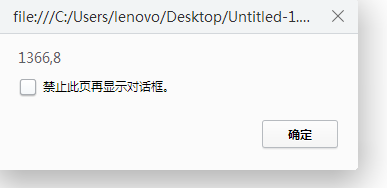1.getElementsByName():獲取name.
~~~~~~~~~~~~~~~~~~~~~~~~~~~~~~~~~~`
例:
<p name="pn">hello</p>
<p name="pn">hello</p>
<p name="pn">hello</p>
<script>
function getName(){
var count=document.getElementsByName("pn");
alert(count.length);
var p=count[2];
p.innerHTML="world";
}
</script>
結果:界面打印出三個hello,並且伴有一個提示框“3”,當點擊確定後,界面顯示的內容變為hello hello world
~~~~~~~~~~~~~~~~~~~~~~~~~~~~~~~~~~~~~~~~~~~~~~~~~··
2.getElementsByTagName():獲取元素。
~~~~~~~~~~~~~~~~~~~~~~~~~~~~~
例
<p>hello</p>
<p>hello</p>
<p>hello</p>
<script>
function getName(){
var count=document.getElementsByTagName("p");
alert(count.length);
var p=count[2];
p.innerHTML="world";
}
</script>
結果:界面打印出三個hello,並且伴有一個提示框“3”,當點擊確定後,界面顯示的內容變為hello hello world
~~~~~~~~~~~~~~~~~~~~~~~~~~~~~~~~~~~~~~~~~~~~~~~~~~
3.getAttribute():獲取元素屬性。
~~~~~~~~~~~~~~~~~~~~~~~~~~~~~~~~~~
例
<a id="aid" title="得到a的標簽屬性"></a>
<script>
function getAttr1(){
var anode=document.getElementById("aid");
var attr=anode.getAttribute("id");
alert("a的ID是:"+attr);
}
function getAttr2(){
var anode=document.getElementById("aid");
var attr=anode.getAttribute("title");
alert("a的title內容是:"+attr);
}
getAttr1();
getAttr2();
</script>
結果:彈出提示框“a的ID是:aid”.點擊確定後,彈出提示框“a的title內容是:得到a的標簽屬性”。
~~~~~~~~~~~~~~~~~~~~~~~~~~~~~~~~~~~
4.setAttribute()設置元素屬性。
~~~~~~~~~~~~~~~~~~~~~~~~~~~~~~~~~~~~
例
<a id="aid2">aid2</a>
<script>
function setAttr(){
var anode=document.getElementById("aid2");
anode.setAttribute("title","動態設置a的title屬性");
var attr=anode.getAttribute("title");
alert("動態設置的title值為:"+attr);
}
setAttr();
</script>
結果:彈出提示框“動態設置的title值為:動態設置a的title屬性”。
~~~~~~~~~~~~~~~~~~~~~~~~~~~~
5.childNodes():訪問子節點。
~~~~~~~~~~~~~~~~~~~~~~~~~~··
例
<ul><li>1</li><li>2</li><li>3</li></ul>
<script>
function getChildNode(){
var childnode=document.getElementsByTagName("ul")[0].childNodes;
alert(childnode.length);
alert(childnode[0].nodeType);
}
getChildNode();
</script>
結果:界面打印出.1 .2 .3彈出對話框“3”,按確定後彈出“1”。
~~~~~~~~~~~~~~~~~~~~~~~~~~~~~~~~~~~~~~~~
6.parentNode():訪問父節點。
~~~~~~~~~~~~~~~~~~~~~~~~~~~~~~~~·
例
<div>
<p id="pid"></p>
</div>
<script>
function getParentNode(){
var div=document.getElementById("pid");
alert(div.parentNode.nodeName);
}
getParentNode();
</script>
結果:彈出提示框:DIV.
~~~~~~~~~~~~~~~~~~~~~~~~~~~~~~~~~~
7.createElement():創建元素節點。
~~~~~~~~~~~~~~~~~~~~~~~~~~~~~~~~
例:
<script>
function createNode(){
var body=document.body;
var input=document.createElement("input");
input.type="button";
input.value="按鈕";
body.appendChild(input);//插入節點
}
createNode();
</script>
結果:出現一個按鈕。
~~~~~~~~~~~~~~~~~~~~~~~~~~~
8.createTextNode():創建文本節點。
~~~~~~~~~~~~~~~~~~~~~~~~~~~~~~
例:
<script>
function createNode(){
var element = document.createElement("div");
element.className = "message";
var textNode = document.createTextNode("Hello world!");
element.appendChild(textNode);
document.body.appendChild(element);
}
createNode();
</script>
代碼分析:這個例子創建了一個新<div>元素並為它指定了值為“message”的class特性。然後,又創建了一個文本節點,並將其添加到前面創建的元素中。最後一步,就是將這個元素添加到了文檔中的<body>元素中,這樣可以在浏覽器中看到新創建的元素和文本節點了。
結果:頁面顯示hello world。
~~~~~~~~~~~~~~~~~~~~~~~~~~~~~~~~~~~~~~~~~~~
9.insertBefore():插入節點。
~~~~~~~~~~~~~~~~~~~~~~~~~~~~~~~~
例
<div id="div">
<p id="pid">p元素</p>
</div>
<script>
function addNode(){
var div=document.getElementById("div");
var node=document.getElementById("pid");
var newnode=document.createElement("p");
newnode.innerHTML="動態插入一個p元素";
div.insertBefore(newnode,node);
}
addNode();
</script>
結果:界面打印出:動態插入一個p元素
p元素
~~~~~~~~~~~~~~~~~~~~~~~~~~~~~~~~~~~~~~~
10.removeChild():刪除節點。
~~~~~~~~~~~~~~~~~~~~~~~~~~~~~·
例
<div id="div">
<p id="pid">p元素</p>
</div>
<script>
function removeNode(){
var div=document.getElementById("div");
var p=div.removeChild(div.childNodes[1]);
}
removeNode();
</script>
結果:界面什麼也沒顯示。
~~~~~~~~~~~~~~~~~~~~~~~~~~~~~~~~~~~
11.offsetHeight:網頁尺寸
12.scrollHeight:網頁尺寸
~~~~~~~~~~~~~~~~~~~~~~~~~~~·
例:
<script>
function getSize(){
var width=document.documentElement.offsetWidth||document.body.offsetWidth;//解決兼容問題
var height=document.documentElement.offsetHeight||document.body.offsetHeight;
alert(width+","+height);
}
getSize();
</script>
顯示結果:

這篇文章主要介紹了JS DOM 來控制HTML元素,文章內容主要包括關於DOM,HTML等,文章來自網絡,請參考。